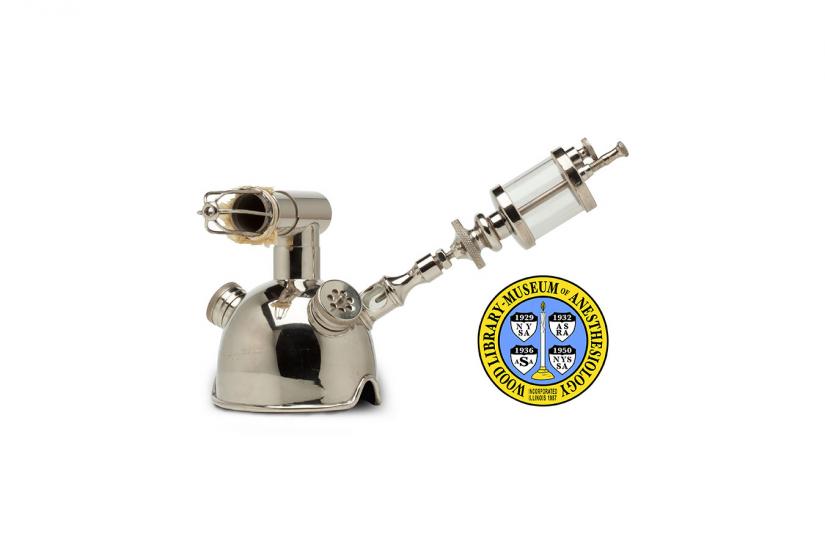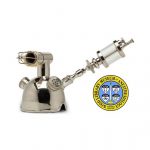Houzel Inhaler
The French physician, Dr. Gaston Houzel introduced the first model of his anesthetic inhaler in 1918. It was used in the treatment of wounded French soldiers during World War I. He described the improved model of his "Dosimetric Apparatus”, seen here, in 1920. It could administer liquid anesthetics alone, or in combination with carbon dioxide. The glass drip chamber was used to administer either chloroform or ether alone, or mixtures of alcohol, chloroform and ether (A.C.E.). Alternatively, the reservoir could be replaced with an ampoule of ethyl chloride. The dose was controlled by a dial on the stem that holds the chamber, or the ampoule. The mask has both a one-way expiratory valve and a two-way rebreathing valve, either of which could be closed while the other was in use.
Catalog Record: Houzel Inhaler Houzel Inhaler
Access Key: aknw
Accession No.: 1998-05-07-1
Title: [ Appareil dosimétrique à chlorure d’éthyle] / [Gaston Houzel].
Author: Houzel, Gaston.
Title variation: Alt Title
Title: Houzel inhaler.
Publisher: Paris : Guyot, [1920-1940].
Physical Description: 1 inhaler ; metal, glass, wood, textile : 13.5 x 22 x 17.5 cm.
Subject: Anesthesia, Inhalation – instrumentation.
Subject: Inhalers, Anesthesia – France.
Subject: Ethyl Chloride.
Web Link: http://woodlibrarymuseum.org/museum/item/662/houzel-inhaler
Note Type: General
Notes: The early year in the date range for the possible year of manufacture is based on the year that Dr. Houzel introduced the modification in “Presse Médicale” (1920). The end date for the possible year of manufacture is a rough estimate based on decreasing references to the inhaler in various publications, including catalogs. The date range could change if new documentation that indicates that the dates should be corrected.
Note Type: General
Notes: Title based on the title of Dr. Houzel’s 1920 article in “Presse Médicale”, and on the name of the object in Guyot catalogs.
Note Type: Citation
Notes: Anesthésie. Appareils et Instruments pour la médecine la chirurgie l’Orthopédie. Paris: Fernand Guillot et Guyot; 1934:66.
Note Type: Citation
Notes: Anesthésie. Fabrique d’Instruments de Chirurgie, Mobilier Chirurgical, Stérilisation, Orthopédie, Bandages & Électricité Médicale. [Paris: Guyot, 1930]:25.
Note Type: Citation
Notes: Houzel (appareil dosimétrique de). Histoire de Médecine de l’Anesthésie et de la Réanimation website. http://www.histanestrea-france.org/SITE/Appareil-dosimetrique-de-Houzel.html. Accessed November 12, 2013.
Note Type: Citation
Notes: Houzel G. Appareil dosimétrique à chlorure d’éthyle et à anesthésies combinées. Presse Méd. September 11, 1920;1(65).
Note Type: Citation
Notes: Houzel G. A dosimetric apparatus for ethyl-chlorid and combined anaesthesia. Bull Mem Soc Chir Par. 1919;45:164.
Note Type: Citation
Notes: Zimmer M. L’anesthésie générale au chlorure d’éthyle. Histoire de l’Anesthénsie. Les Ulis, France: EDP Sciences; 2008:562-563.
Note Type: Physical Description
Notes: One wood box with a metal handle and latch, with apparatus for the administration of anesthesia inside; The largest piece of the set is the oronasal mask, which is all metal except for a thick piece of felt tucked in a drip guard; The mask has two valves to control the intake of room air and the release of air from under the mask; There is also an open connection for a rebreathing bag; The number “14” is marked on the connection; The metal extension for the rebreathing bag is detached for storage in the box; The numbers “14” and “0” are marked on the extension near the connection for the bag; Finally extending from the mask is the drip chamber and the opening for a tube of ethyl chloride or the metal and glass container for the liquid anesthetic; Marked on this extension is “GUYOT” and “BTÉ. S.G.D.G.”; The metal and glass container for the liquid anesthetic is detached for storage in the box.
Note Type: Reproduction
Notes: Photographed by Mr. Steve Donisch, June 10, 2013.
Note Type: Historical
Notes: This inhaler was invented by French surgeon Gaston Houzel and manufactured by Guyot of Paris. Introduced in 1920, it is a modified version of one Houzel began using around 1918 at the Couchin Hospital in Paris near the end of World War I. His patients included those injured during the war.
Note Type: Historical
Notes: Houzel referred to his invention as a ‘dosimetric apparatus for ethyl chloride and combined anesthesia.’ The dose of liquid anesthetic could be measured and controlled by observing and adjusting the drip rate as viewed via a metal and glass chamber that extended from the mask.
Note Type: Historical
Notes: Under the mask a piece of flannel or felt was tucked into a drip guard to absorb the liquid anesthetic and prevent it from spilling onto the patient’s skin. The anesthetic was dispensed from a tube of ethyl chloride, or from a metal and glass chamber containing a mixture of anesthetics. The mask also has an attachment for a rebreathing bag, and two valves to control the flow of fresh air into the mask and the release of air exhaled from the patient.
Note Type: Historical
Notes: Houzel originally designed the inhaler for the administration of ethyl chloride, a popular brand of which was called Kélène. The inhaler could also be used to administer mixtures of anesthetics, such as methyl chloride and chloroform, or A.C.E (alcohol, chloroform, and ether).
Note Type: Exhibition
Notes: Chosen for the WLM website.


